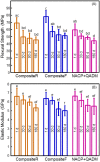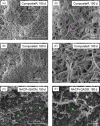Antibacterial nanocomposite with calcium phosphate and quaternary ammonium
- PMID: 22403412
- PMCID: PMC3327730
- DOI: 10.1177/0022034512440579
Antibacterial nanocomposite with calcium phosphate and quaternary ammonium
Abstract
Secondary caries is a frequent reason for restoration failure, resulting from acidogenic bacteria and their biofilms. The objectives of this study were to: (1) develop a novel nanocomposite containing nanoparticles of amorphous calcium phosphate (NACP) and quaternary ammonium dimethacrylate (QADM); and (2) investigate its mechanical and antibacterial durability. A spray-drying technique yielded NACP with particle size of 116 nm. The nanocomposite contained NACP and reinforcement glass fillers, with QADM in the resin. Two commercial composites were tested as controls. Composites were inoculated with Streptococcus mutans. After 180-day water-aging, NACP+QADM nanocomposite had flexural strength and elastic modulus matching those of commercial controls (p > 0.1). NACP+QADM nanocomposite reduced the biofilm colony-forming units (CFU) by 3-fold, compared with commercial composites (p < 0.05). Metabolic activity and lactic acid production of biofilms on NACP+QADM were much less than those on commercial composites (p < 0.05). The antibacterial properties of NACP+QADM were maintained after water-aging for 30, 90, and 180 d (p > 0.05). In conclusion, the novel NACP-QADM nanocomposite greatly decreased biofilm metabolic activity, CFU, and lactic acid, while matching the load-bearing capability of commercial composites without antibacterial properties. The NACP-QADM nanocomposite with strong and durable antibacterial properties, together with its previously reported Ca-PO(4) release capability, may render it useful for caries-inhibiting restorations.
Conflict of interest statement
The author(s) declare no potential conflicts of interest with respect to the research, authorship, and/or publication of this article.
Figures




Similar articles
-
Dental plaque microcosm biofilm behavior on calcium phosphate nanocomposite with quaternary ammonium.Dent Mater. 2012 Aug;28(8):853-62. doi: 10.1016/j.dental.2012.04.024. Epub 2012 May 10. Dent Mater. 2012. PMID: 22578992 Free PMC article.
-
Antibacterial amorphous calcium phosphate nanocomposites with a quaternary ammonium dimethacrylate and silver nanoparticles.Dent Mater. 2012 May;28(5):561-72. doi: 10.1016/j.dental.2012.01.005. Epub 2012 Feb 2. Dent Mater. 2012. PMID: 22305716 Free PMC article.
-
Synthesis of new antibacterial quaternary ammonium monomer for incorporation into CaP nanocomposite.Dent Mater. 2013 Aug;29(8):859-70. doi: 10.1016/j.dental.2013.05.005. Epub 2013 Jun 14. Dent Mater. 2013. PMID: 23768794 Free PMC article.
-
Strong nanocomposites with Ca, PO(4), and F release for caries inhibition.J Dent Res. 2010 Jan;89(1):19-28. doi: 10.1177/0022034509351969. J Dent Res. 2010. PMID: 19948941 Free PMC article. Review.
-
Developing a New Generation of Antimicrobial and Bioactive Dental Resins.J Dent Res. 2017 Jul;96(8):855-863. doi: 10.1177/0022034517709739. Epub 2017 May 22. J Dent Res. 2017. PMID: 28530844 Free PMC article. Review.
Cited by
-
Bactericidal and Bioactive Dental Composites.Front Physiol. 2018 Feb 16;9:103. doi: 10.3389/fphys.2018.00103. eCollection 2018. Front Physiol. 2018. PMID: 29503619 Free PMC article.
-
Nanotechnology strategies for antibacterial and remineralizing composites and adhesives to tackle dental caries.Nanomedicine (Lond). 2015 Mar;10(4):627-41. doi: 10.2217/nnm.14.191. Nanomedicine (Lond). 2015. PMID: 25723095 Free PMC article. Review.
-
A novel protein-repellent dental composite containing 2-methacryloyloxyethyl phosphorylcholine.Int J Oral Sci. 2015 Jun 26;7(2):103-9. doi: 10.1038/ijos.2014.77. Int J Oral Sci. 2015. PMID: 25655010 Free PMC article.
-
Cellulose Nanocrystal Surface Cationization: A New Fungicide with High Activity against Phycomycetes capsici.Molecules. 2019 Jul 4;24(13):2467. doi: 10.3390/molecules24132467. Molecules. 2019. PMID: 31277526 Free PMC article.
-
Development of novel self-healing and antibacterial dental composite containing calcium phosphate nanoparticles.J Dent. 2015 Mar;43(3):317-26. doi: 10.1016/j.jdent.2015.01.009. Epub 2015 Jan 24. J Dent. 2015. PMID: 25625674 Free PMC article.
References
-
- Bayne SC, Thompson JY, Swift EJ, Jr, Stamatiades P, Wilkerson M. (1998). A characterization of first-generation flowable composites. J Am Dent Assoc 129:567-577 - PubMed
-
- Beyth N, Yudovin-Farber I, Bahir R, Domb AJ, Weiss EI. (2006). Antibacterial activity of dental composites containing quaternary ammonium polyethylenimine nanoparticles against Streptococcus mutans. Biomaterials 27:3995-4002 - PubMed
-
- Beyth N, Domb AJ, Weiss EI. (2007). An in vitro quantitative antibacterial analysis of amalgam and composite resins. J Dent 35:201-206 - PubMed
Publication types
MeSH terms
Substances
Grants and funding
LinkOut - more resources
Full Text Sources
Medical

